Pygmy goats are a miniature breed that is closely related to the Nigerian Dwarf goat. In fact, when this small stature meat goat arrived in the United States, it took quite a while for zookeepers to realize they actually possessed a herd comprised of two distinct breeds instead of just one.
This miniature goat breed was once thought to be nothing more than a cute curiosity animal best relegated to petting zoos. In spite of their miniature size, Pygmy goats are not only strong, but also make excellent meat goats.
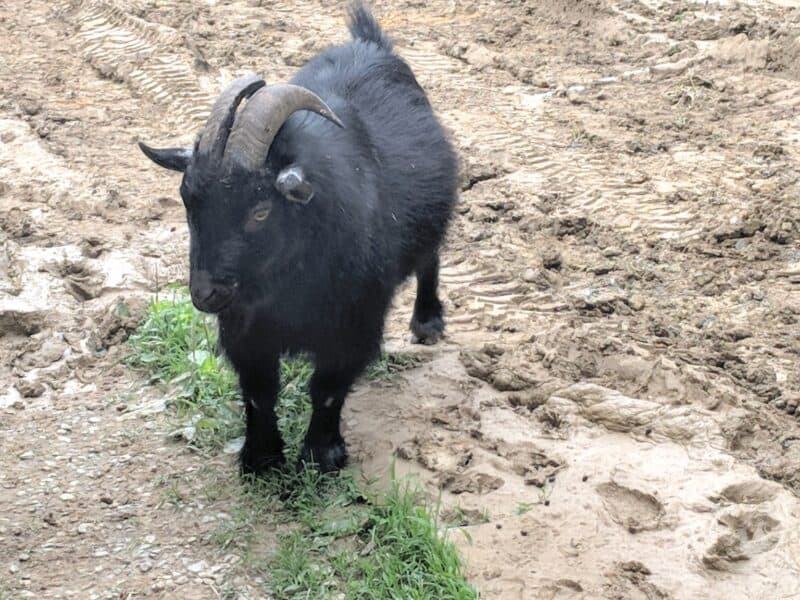
When treated like livestock instead of a pet, Pygmy goats become excellent browsers, and can easily be taught to free range for their own food – offering the homesteaders who keep them labor and fuel free lawn mowing and weed eating services.
Pygmy goats are hardy animals by nature, but thrive in even hot climates with low quality brush to eat due to the African heritage.
Table of Contents:
History of Pygmy Goats
None of the first Pygmy goats that set sail for the United States were supposed to make it here alive. In the 1950s, a ship journeying from West Africa to several zoos with tigers destined to become attractions also contained a substantial herd of Pygmy goats. Nigerian Dwarf goats were on board as well but, at the time, there was no breed distinction among the herds.
The miniature goats were herded onto the ship to become feeder animals for the large cats. When the West African ship reached its final destination, the Gladys Porter Zoo near Brownsville, Texas, many of the Pygmy goats were left alive.
The Gladys Porter Zoo staff quickly became enamored with the adorable and lively miniature goats, and worked out an agreement to keep them at the facility.
Initially, Pygmy goats and their Nigerian Dwarf goat companions were ushered into the petting zoo and became an extremely popular attraction.
It was the zoo staff at the Brownsville facility that started referring to the miniature goats as Pygmies. One day, several zookeepers took notice of the difference in body structure, height, horns, and facial structure on the growing West African goats.
Some of the miniature goats had a body style that more closely resembled a standard stature dairy goat and the others had features more akin to standard size meat goats.
Two area goat keepers, Sharlea Parker of Willows Farm and Kathleen Clapp from Goodwood Farms, were permitted to develop separate herds for each type of newly discovered goat breed. These two women have been soundly credited with developing and promoting both the Pygmy goat and Nigerian Dwarf goat breeds across the United States.
Many registered goats from both breeds can trace their origins all the way back to that first herd of feeder goat survivors that traveled to Texas from West Africa.
Pygmy Goat Pros and Cons
This is a fairly quiet breed of goat – unless their meal is late or it is mating season. A Billy goat will make a lot of noise when he is going courting.
If you live on a small acreage homestead or are keeping a couple of Pygmy goats in the backyard, expect some type of reaction from neighbors from the wanton advances by your Billy goat.
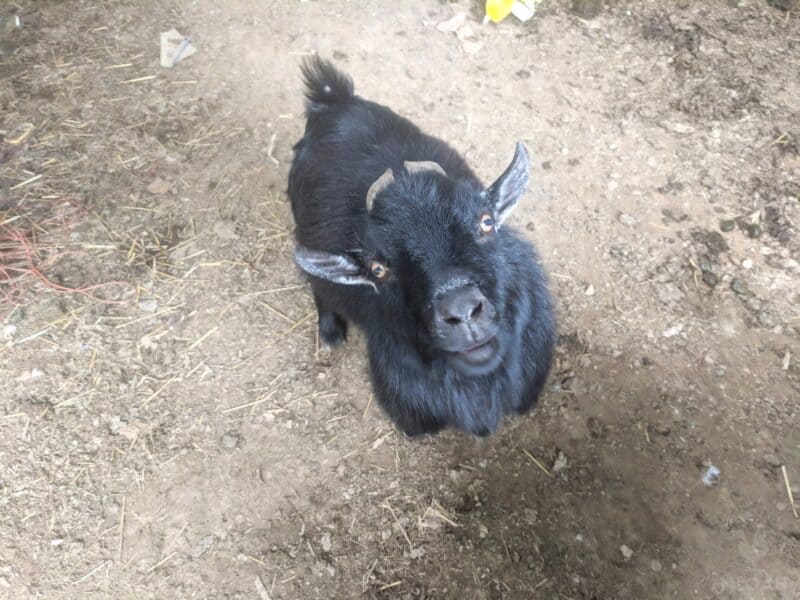
When Pygmy goats and Nigerian goat are cross bed, which is incredibly common, the kids typically resemble one or the other of their parents and not a mixture of both.
Rooster, Pearl and Not Negan’s first kid has his momma’s coat color and physique, but the next batch of kids – a set of boy – girl twins, looked like their poppa.
When a Billy goat is attempting to convince a nanny or doe to mate with him, he will urinate on himself and excrete quite a distinctive and unpleasant musk scent – which also may cause a neighbor or two to take notice.
A Pygmy goat is typically a quieter pet than a dog, and is not bigger in size than a large dog breed. My nanny goat and blue heeler are almost identical in size, with the heeler being just slightly bulkier and taller than Pearl.
The biggest single complaint I have ever heard from a miniature goat keeper is they fall in love with them, prohibiting them from stopping with just a couple goats.
Goats on Large Acreage Homesteads
Some folks are under the misconception that miniature goats like the Pygmy breed are really only for backyard and small homesteaders – nothing could be further from the truth.
While these small stature goats are ideal for a small homesteads, they also have much to offer large homesteaders like myself.
A herd of just 10 Pygmy goats possesses the capability to clear an acre of land every 30 days. If you live on a large farm or homestead, the value of putting these goats to work on clearing out brush, keeping a hillside cut back, or simply doing the work of a lawn mower and weed eater for you cannot be underestimated as a both a time and money saver.
Simply because you have a lot of land does not mean you have ample grazing or browsing space for a plethora of livestock. Goats, especially miniature ones, take up less space to house, and eat less than their standard size peers.
Pygmy goats can sustain themselves to a substantial degree on twigs, weeds, fallen leaves, and other lesser quality natural matter they find on or near ground level, even during the winter months.
Given the opportunity, they will join the horses and cattle in the pasture, which is something you will need fencing to avoid if doing so could run you short on quality grazing area for larger livestock.
Pygmy Goats for Meat
A mature male Pygmy goat ranges in size from 45 to 65 pounds (20 to 30 kgs), on average – some reach weights of 85 pounds (38 kilograms). The butcher weight of Pygmy goats is typically 20 to 25 pounds (9 to 11 kgs).
While goat meat is not consumed in large quantities traditionally in the United States, its popularity as a lean meat is growing. Meat from goats is considered a red meat, but it is comprised of far less cholesterol and fat that chicken, pork, or beef.
A single three ounce (85 grams) serving of goat meat boasts just 122 calories but still contains around 23 grams of protein.
Pygmy Goats for Dairy
Pygmy goats are traditionally raised for their meat and not milk, but the high butterfat content of their milk does offer a pleasing taste.
The teats on Pygmy goats are smaller than those on Nigerian Dwarf goats, making the milking process more tedious for both the goat and the person tasked with milking her.
Kids Teaching Kids
Keeping Pygmy goats is an excellent and affordable way to introduce homesteading skills to children. These miniature goats are a favorite among young 4-H members who are aging up from taking chickens and rabbits – or who prefer to start with a larger yet still easy to handle animal.
In addition to taking market goats as a fair project, miniature goats can also be shown as breeding animals, pack animals, cart animals, fiber animals, and of course, as dairy animals.
It is possible to take a Pygmy goat one year to show in one category and take the same animal and enter it in different categories the following years – allowing the connection and learning between the goat and the child to grow together.

Goat Rental
Keeping a herd of these little powerhouse eaters and rompers on your homestead can also be an excellent way to make some extra cash.
Renting out goats for brush clearing is becoming more and more common not just in rural areas, but on building sites in more suburban and even urban areas, as well.
To be able to safely and securely rent your herd of Pygmy goats you will need a portable electric fence designed to contain medium livestock.
Electric goat netting comes with lightweight yet sturdy step-in plastic posts attached. The netting rolls up when for transport and can quickly be temporarily erected in the ground at the spot where the goats are intended to browse for food.
This type of fencing should never be considered the sole type of fencing to use on a permanent basis, but is effective for short term day use during browsing rentals and for rotating the goat herd for on the homestead so they can browse different areas throughout the year and during pen cleaning.
Goat Yoga
Renting out the herd of miniature goats for goat yoga, or teaching a class on your homestead, is yet another way to turn your homestead into a money making opportunity – and to ensure the Pygmy goats earn their keep.
Goat yoga has only been around for a short while, but it has definitely captured the attention of yoga and miniature goat enthusiasts alike.
Facts
Pygmy goats possess coats that come in a wide range of colors. The most common type of goat coat for members of this breed is brown, but Pygmy goat association and club standard indicate Goats of this breed come in a vast array of colors, but the more prominent coat shade is brown.
Breed standards maintain these miniature goats come in seven different colors: caramel with brown markings, solid black, caramel with black markings, black agouti, brown agouti, and gray agouti.
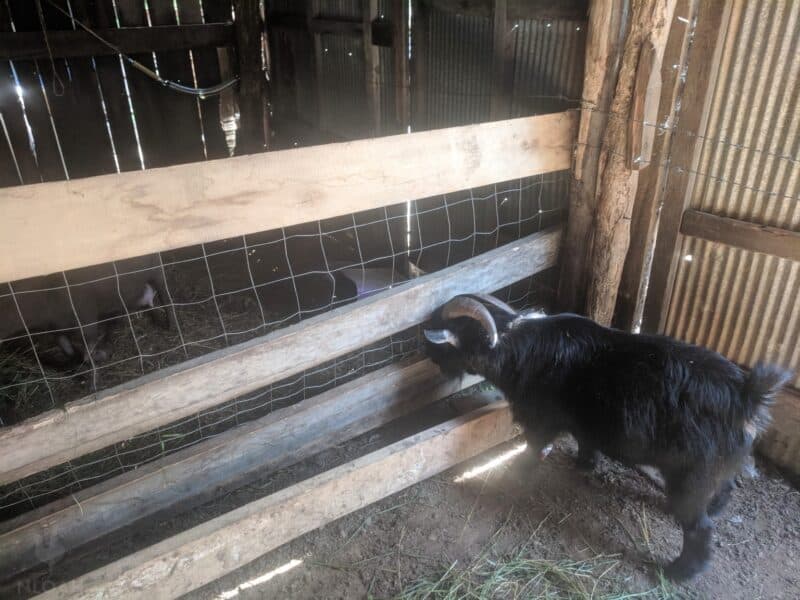
Agouti is a shade that refers to a phenotype gene that determines how the pigment in the hair is distributed. Agouti is a grayish color with a salt and pepper brindled appearance scattered through it that is common in many types of animals.
The ears of Pygmy goats often have a beautiful speckled agouti appearance, sometimes with white tips on the end.
Pygmy goats only ever have brown eyes. The pupil of the eyes are are roughly rectangular in shape. The rectangular pupils that are common among hooved animals, allows them to enjoy 320 to 340 degree peripheral vision instead of the 160 to 210 degree vision common among people.
Like horses, goats also have excellent night vision, which helps protect them from predators.
Pygmy Goats Weight
A mature wether (castrated male) or mature female Pygmy goat weighs between 40 to 55 pounds (18 to 24 kgs) on average. A mature Billy goat (or buck) tends to weigh a little more, usually topping out as a maximum of 80 to 85 pounds (36 to 38 kgs).
Pygmy Goats Height
Mature Pygmy goats typically grow to 16 to 24 inches (40 to 61 cm) tall. On average, mature Pygmy goats stand about 18 inches tall (45 cm).
Lifespan
The lifespan of a Pygmy goat is 12 to 15 years on average, but some of these miniature goats live up to 20 years old.
Goats are not the type of animals that mate for life – at least they are not supposed to be. It is best to keep multiple nannies and does for a single Billy goat.
While Not Negan was thrilled when when more ladies came into the herd, Pearl was not. The two had been a pair for so long that Pearl viewed the new does as a threat, and it took months for her to stop ramming them, allow them around Not Negan, and accept them into the herd.
Breeding
- The gestation period for Pygmy goats is approximately five months, with kids being completely weaned by the time they are 12 weeks old.
- Within just a few moments after being born the 2-4 pound Pygmy kids are standing up and walking about a bit before nursing. Kids are eating a little bit of grain and hay or following their mommas around to browse within just a day after being born. Hawks and eagles can lift prey weighing 5 pounds (over 2 kgs), making miniature goat kids a prime target for these birds of prey. Keeping mini goat kids in a covered nursing stall until they weigh more than five pounds is highly recommended.
- Each baby goat kid possesses its own unique scent and “calling” sound so its momma can identify it in a herd.
- A nanny Pygmy goat does not have a designated mating or heat period. If allowed to freely spend time with a Billy goat she will mate up to four times a year.
- A Billy goat will try to mate more often, even right after kidding, if permitted free access to a nanny. Mating too frequently can harm a nanny severely, and also cause either a stillborn or unhealthy kid to be born.
- The ideal ratio between male and female mature Pygmy goats is one Billy for every three females.
- A nanny goat typically gives birth to one kid during her first kidding and twins every following kidding – but triplets are sometimes also possible.
- Fun Fact: Goat babies have been called kids for centuries. It was not until the early 1800s that some savvy person thought the romping around, full of energy, and snuggling tendencies of human little ones reminded them of baby goats and children were nicknamed, “kids”.
Personality
This miniature goat breed is highly affectionate, hence their popularity as farm pets and petting zoo attractions. They are herd animals thrive on the companionship of each other and the humans around them.
While using dogs as companion animals is incredibly common, Pygmy goats and Nigerian Dwarf goats are infringing on their territory.
Keepers of these mini goats are now more frequently involved in companion animal breeding and training, as well as taking herd members to visit hospitals, veterans facilities, and nursing homes to cheer up the residents.
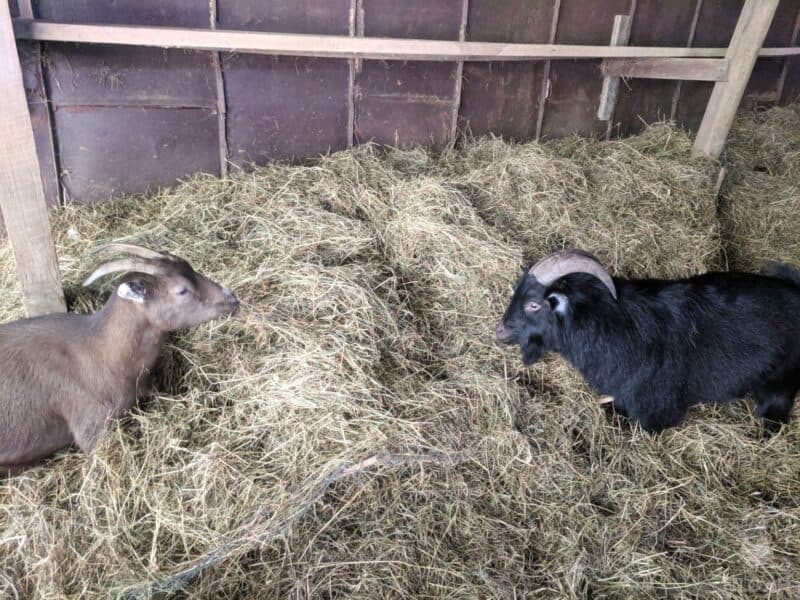
My Pygmy Billy goat, Not Negan, is shown above with his Nigerian Dwarf mate, Pearl. He hangs with the horses all day except during feed time and when mating.
He is my boss mare’s sidekick and has no problem backing down any of the other horses, ponies, or miniature donkeys. Yet, he minds Pearl and treats her gently. Not Negan is the most docile billy goat with humans that anyone could ever want.
Pygmy goats can easily be taught to walk on a lead rope like dogs or horses, but potty training does require a bit of patience. These are intelligent little goats.
I taught my first nanny goat to free range alongside my dog in just a couple of days. When I added her mate, I only had to keep him penned up a single night before turning him loose to follow his lady around.
In four years, none of my goats have ever crossed their designated boundaries – which they could easily do by climbing under the barbed wire pasture fencing.
If you free-range your herd of miniature goats, expect them to show up at your back door if their morning meal is late. They are true creatures of habit and prefer to never-ever, have their schedule re-arranged.

Pen and Habitat
Because Pygmy goats are so social and high energy, these miniature goats need companions as well as “boredom busters” in their pen to avoid their destructive or aggressive behavior.
A free-ranging herd will find many ways to entertain itself, and have ample natural “playground” material to romp around.
If the terrain is at least rocky in some parts, you probably will not have to trim the hooves of each goat ever six to eight weeks. I have never once had to trim the hooves on our miniature herd.
Pygmy goats are typically excellent foragers, and will range about browsing for as much of their own food as possible year round.
When keeping Pygmy goats in a pen, make sure all of the tree stumps, barrels, boards, and other DIY natural or man-made play materials are secured into a place in the center of the pen to avoid the goats from using them as leverage to jump out of their pen. You can easily incorporate a play and climbing structure into the design of the goat house.
The fencing on the goat pen must be durable enough to withstand frequent to constant pushing on it by the goats as they scratch their backs, and in-between their horns on the barrier.
If kept in a pen and not allowed to free range, make sure to add natural or man-made climbing features to the Pygmy goat to “play on.” A border goat can become aggressive and destructive in a short amount of time.
The openings in the goat fencing should be no more than two inches apart to prevent climbing. The gate will need to be as tall as the pen fencing material, have a two step lock, and also adhere to the maximum opening recommendations to prevent climbing or little heads pushing through the fence and getting stuck on the horns.
The goats will require a shelter that they can surely be closed into at night to avoid becoming a meal for predators. The fencing that surrounds the pen must be 3 to 4 feet to deter climbing or jumping out by the herd members – or access to predators.
If you are on a small homestead where space is limited, consider combining a miniature goat pen and a chicken coop.
Even if you keep the goats in a pen their entire lives, strive to allow them to use their natural browsing instincts and dine upon hay and other foods you grow or buy for them to eat and place inside.
Feeding a Pygmy goat (or any goat) too much grain and treats will not only destroy these innate desires, but cause them to contract bloat and other ruminant related medical problems.
Giving healthy treats in moderation is fine, especially during training, but avoid excessive grains – like bread and crackers and stick to leaf greens, edible flowers, carrots, and a small amount of goat – safe fruit.
Planting some blackberry bushes inside the goat pen will allow them to browse on a healthy seasonal treat.
Health Tips
These miniature goats are hardy in nearly any climate. If kept in a proper draft free but not tightly close pen, the chances of them catching goat pneumonia, a common affliction among all goat breeds, will decrease substantially.
Feeding the goats in a clean feeder and not on the ground inside their pen or shelter – where there droppings also exist, will help prevent them from contracting worms and infections from bacteria.
Worming the goats every four to six weeks is common. It is especially important to rotate pastures to allow any worms in droppings to die (takes three days) and keeping the ground in the pen clean to prevent parasite infestations.
Mucking the pen area with a tractor or pitchfork, just as you would a horse stall, with the sprinkling or fresh straw, will also help prevent worm problems.
I use an old refrigerator turned on its back as a feed tub to protect the feed from moisture, parasites, and rodents. I also pour in a 25 to 50 pound (11 to 22 kg) bag of Diatomaceous Earth (agriculture grade only) into the feed, and stir it about as a natural worm deterrent.
A myriad of vaccinations exist for goats, most of which are available at a local agricultural supply store like Rural King or Tractor Supply.
Top 4 Pygmy Goat Diseases
- John’s Disease – This is a contagious infection caused by a bacteria that can live (but not grow) in the soil for months. It is common among all ruminant animals.
- Coccidiosis – This contagious goat disease is caused by microscopic parasites.
- Scrapie – Scrapie is a fatal and degenerative disease that afflicts only goats and sheep.
- Urinary Calculi – This medical problem afflicts only male goats and sheep. Urinary Calculi is a urinary tract blockage.
Proper husbandry practices, frequent health checks to detect a health problem early, and vaccinating the Pygmy goat herd can help prevent diseases and medical problems common in goat herds.
Should You Raise this Type of Goat?
Keeping a large herd of Pygmy goats is ideal for some homesteaders, but only if you have the space, time, and money to take care of all of them.
Do not let the small stature of these little goats fool you, they are voracious eaters. It will take a single 50-pound (22 kgs) square bale of hay to feed two mature Pygmy goats per day during the winter months when browsing opportunities are limited to non-existent.
Pygmy Goat FAQ
Yes, pygmy goats are meat goats.
Pygmy goat prices vary, but you can typically get one for $100 – $150. The price may include various state taxes such as sales tax.
Pygmy goats make great pets. They’re very friendly and including with kids, and very playful. But, you can’t house train them.
Yes, you can eat pygmy goat meat. In fact, this is the main reason they’re raised, not milk.
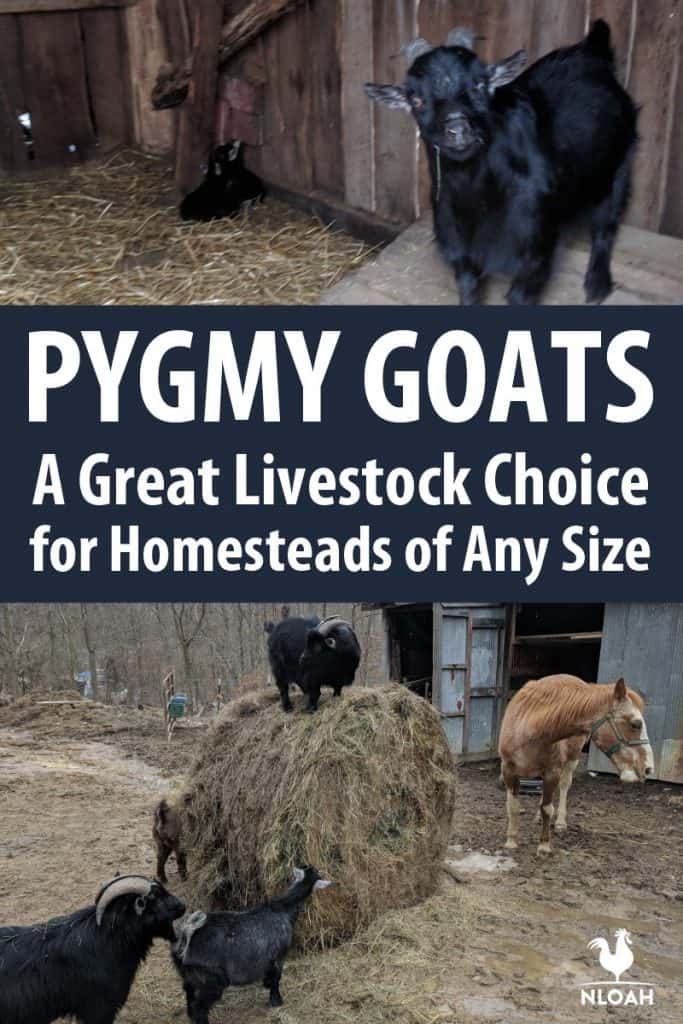

Tara lives on a 56 acres farm in the Appalachian Mountains, where she faces homesteading and farming challenges every single day, raising chickens, goats, horses, and tons of vegetables. She’s an expert in all sorts of homesteading skills such as hide tanning, doll making, tree tapping, and many more.

Nice article.
Sawdust sprinkled on the floor of the stalls, pens, coups, feeding areas will create a more pleasant atmosphere for you and your animals by eliminating odor causing bacteria. Sawdust is also excellent for compost heaps, composting crappers, as well as old school crappers.
The best thing about sawdust in your area is that it is probably free or next to it from your local sawmill and they may even load it.
Susie, you are exactly right, sawdust is a wonderful thing to have around a homestead!
LOVED this! I dont want goats for myself, but I really enjoy learning about all things, so this was excellent. The videos you included were also very entertaining. Thank you, Tara!
Susan, you are very welcome – goats are fun to have in the barnyard!